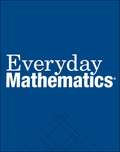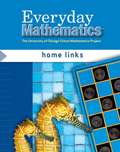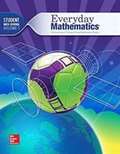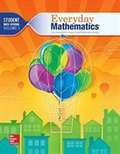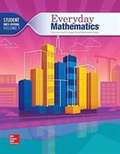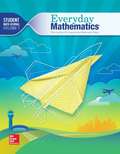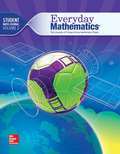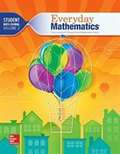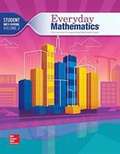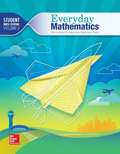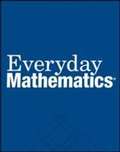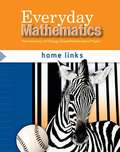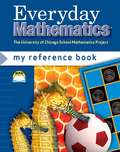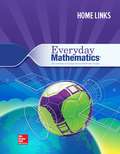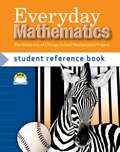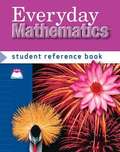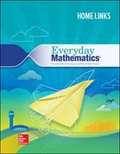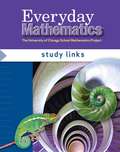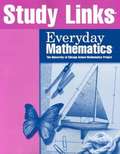- Table View
- List View
Everyday Mathematics, Grade 5, Student Math Journal Volume 1
by The University of Chicago School Mathematics ProjectMath textbook for 5th graders.
Everyday Mathematics, Home Links (Grade #2)
by James Mcbride Andy Isaacs Max Bell Amy Dillard John Bretzlauf Jean Bell Robert Hartfield Kathleen Pitvorec Peter Saecker Cheryl G. MoranThis easy-to-use consumable grade-specific book contains extensions and review problems for each lesson to help families support their children's mathematical development.
Everyday Mathematics, Student Math Journal 2
by The University of Chicago School Mathematics ProjectThis student's educational material on Mathematics contains Exponents and Negative, Fractions and Ratios, Coordinates, Area, Volume, and Capacity, Algebra Concepts and Skills, Volume, Probability, Rations, and Rates.
Everyday Mathematics, Student Math Journal 2
by The University of Chicago School Mathematics ProjectThis book contains useful exercises on Mathematics comprising lessons on Fractions and Their Uses, Chance and Probability, Perimeter and Area, Percents, Reflections and Symmetry, Shapes, Weight, Volume, and Capacity, and Rates.
Everyday Mathematics, Student Math Journal 2
by The University of Chicago School Mathematics ProjectThe Journal provides lesson support material for students to analyze and complete and a long-term record of each student's mathematical development.
Everyday Mathematics, Student Math Journal, Volume 1
by Max Bell Amy Dillard John BretzlaufSupports daily classroom instruction and gives students a long-term record of their mathematical progress and development. Two volumes Grade 1-6 consumable
Everyday Mathematics, Student Math Journal, Volume 1
by Max Bell Jean Bell University of Chicago School Mathematics ProjectNIMAC-sourced textbook
Everyday Mathematics, Student Math Journal, Volume 1
by Max Bell John Bretzlauf University of Chicago School Mathematics ProjectNIMAC-sourced textbook
Everyday Mathematics, Student Math Journal, Volume 1
by Max Bell Robert Balfanz University of Chicago School Mathematics ProjectNIMAC-sourced textbook
Everyday Mathematics, Student Math Journal, Volume 2
by Max Bell Amy Dillard John BretzlaufSupports daily classroom instruction and gives students a long-term record of their mathematical progress and development. Two volumes Grade 1-6 consumable
Everyday Mathematics, Student Math Journal, Volume 2
by Max Bell Jean Bell University of Chicago School Mathematics ProjectNIMAC-sourced textbook
Everyday Mathematics, Student Math Journal, Volume 2
by Max Bell John Bretzlauf University of Chicago School Mathematics ProjectNIMAC-sourced textbook
Everyday Mathematics, Student Math Journal, Volume 2
by Max Bell Robert Balfanz University of Chicago School Mathematics ProjectNIMAC-sourced textbook
Everyday Mathematics: Grade 3
by James Mcbride Andy Isaacs Max Bell Amy Dillard John Bretzlauf Jean Bell Robert Hartfield Kathleen Pitvorec Peter SaeckerYou can use this Student Reference Book to look up and review topics in mathematics.
Everyday Mathematics: Home Links (Grade 3 )
by James Mcbride Andy Isaacs Max Bell Amy Dillard John Bretzlauf Jean Bell Robert Hartfield Kathleen Pitvorec Peter Saecker Mary Ellen DairykoEveryday Mathematics offers children a broad background in mathematics.
Everyday Mathematics: My Reference Book
by Mary Ellen Dairyko Cheryl G. Moran Rachel Malpass MccallA reference book is a book that helps people find information. Some other reference books are dictionaries, encyclopedias, and cookbooks. My Reference Book can help you find out more about the mathematics you learn in class. You can read this reference book with your teacher, your family, and your classmates.
Everyday Mathematics: Student Math Journal 2 (Everyday Math)
by Max Bell Amy Dillard John BretzlaufNIMAC-sourced textbook
Everyday Mathematics: Student Reference Book
by James Mcbride Andy Isaacs Max Bell Amy Dillard John Bretzlauf Jean Bell Robert Hartfield Kathleen Pitvorec Peter SaeckerThis Student Reference Book can be used to look up and review topics in mathematics. It has the following sections: 1) A Table of Contents that lists the sections and shows how the book is organized. 2) Essays within each section. 3) Directions on how to play some of the mathematical games you may have played before. 4) A Data Bank with posters, maps, and other information. 5) A Glossary of mathematical terms. 6) An Answer Key and 7) An Index to help you locate information quickly.
Everyday Mathematics: Student Reference Book
by The University of Chicago School Mathematics ProjectStudents can use this Student Reference Book to look up and review information on topics in mathematics. It consists of the following sections: Table of contents, Essays on mathematical topics, Descriptions of how to use a calculator, Directions on how to play some of the mathematical games, Glossary of mathematical terms, Tables and charts, Answer key, Index, etc.
Everyday Mathematics: Student Reference Book [Grade 3]
by The University of Chicago School Mathematics Project Diana Barrie Max Bell John Bretzlauf Jean BellNIMAC-sourced textbook
Everyday Mathematics: Student Reference Book, Grade 4
by Andy Isaacs Diana Barrie Max Bell Amy DillardNIMAC-sourced textbook
Everyday Mathematics: Student Reference Book, Grade 4 (Everyday Math)
by Max Bell John Bretzlauf Robert BalfanzNIMAC-sourced textbook
Everyday Mathematics: Study Links
by Max Bell Amy Dillard John Bretzlauf Robert HartfieldEveryday Mathematics offers students a broad background in mathematics.
Everyday Mathematics: Study Links
by Mcgraw HillEveryday Mathematics offers students a broad background in mathematics. Some approaches in this program may differ from those you used as a student. However, the approaches the authors use are based on research results, field-test experiences, and the mathematics that students will need in the twenty-first century.
Everyday Mathematics: Study Links (Grade #5)
by The University of Chicago School Mathematics ProjectEveryday Mathematics offers students a broad background in Mathematics. It is part of an elementary school mathematics curriculum developed by the University of Chicago School Mathematics Project.
